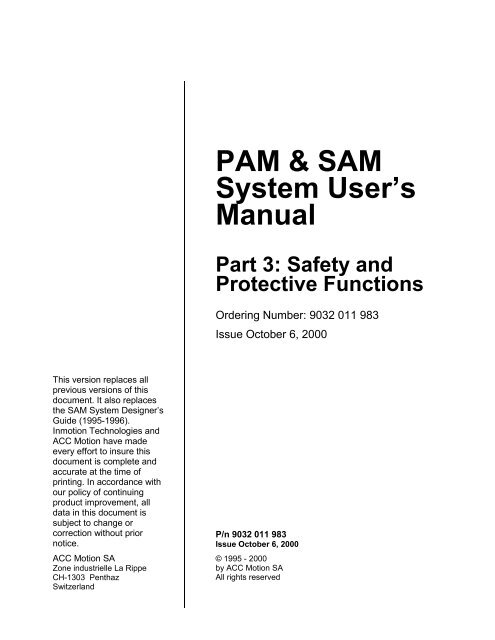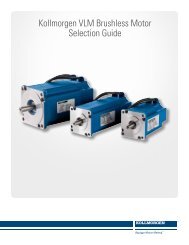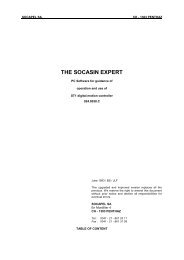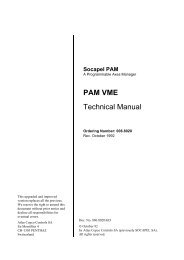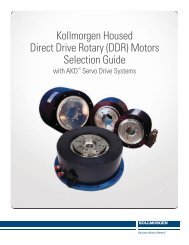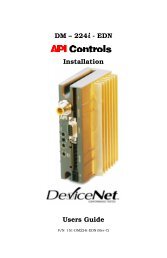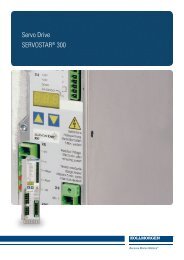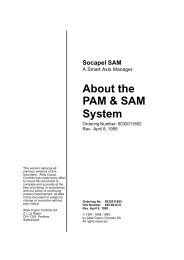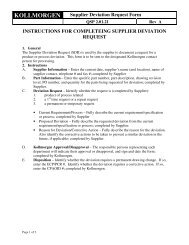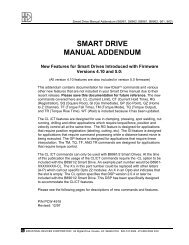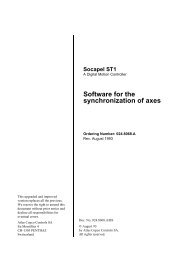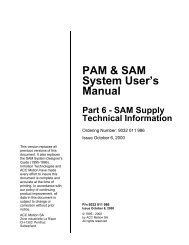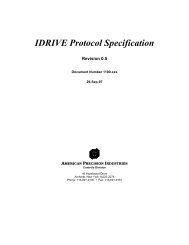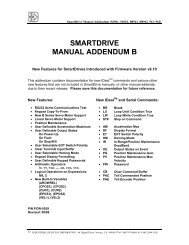PAM & SAM System User's Manual Part 3: Safety and ... - Kollmorgen
PAM & SAM System User's Manual Part 3: Safety and ... - Kollmorgen
PAM & SAM System User's Manual Part 3: Safety and ... - Kollmorgen
Create successful ePaper yourself
Turn your PDF publications into a flip-book with our unique Google optimized e-Paper software.
<strong>PAM</strong> & <strong>SAM</strong><br />
<strong>System</strong> User’s<br />
<strong>Manual</strong><br />
<strong>Part</strong> 3: <strong>Safety</strong> <strong>and</strong><br />
Protective Functions<br />
Ordering Number: 9032 011 983<br />
Issue October 6, 2000<br />
This version replaces all<br />
previous versions of this<br />
document. It also replaces<br />
the <strong>SAM</strong> <strong>System</strong> Designer’s<br />
Guide (1995-1996).<br />
Inmotion Technologies <strong>and</strong><br />
ACC Motion have made<br />
every effort to insure this<br />
document is complete <strong>and</strong><br />
accurate at the time of<br />
printing. In accordance with<br />
our policy of continuing<br />
product improvement, all<br />
data in this document is<br />
subject to change or<br />
correction without prior<br />
notice.<br />
ACC Motion SA<br />
Zone industrielle La Rippe<br />
CH-1303 Penthaz<br />
Switzerl<strong>and</strong><br />
P/n 9032 011 983<br />
Issue October 6, 2000<br />
© 1995 - 2000<br />
by ACC Motion SA<br />
All rights reserved
PART 3 - SAFETY AND PROTECTIVE FUNCTIONS<br />
TABLE OF CONTENTS<br />
<strong>PAM</strong> with <strong>SAM</strong> <strong>System</strong> Users H<strong>and</strong>book<br />
P/n 9032 011 983, October 6, 2000 Page: 2
PART 3 - SAFETY AND PROTECTIVE FUNCTIONS<br />
TABLE OF CONTENTS<br />
Table of Contents<br />
Table of Contents....................................................................................................3<br />
Index of Figures ......................................................................................................3<br />
Index of Tables .......................................................................................................3<br />
Introduction .............................................................................................................5<br />
Overview..............................................................................................................5<br />
Definitions ............................................................................................................5<br />
Implementation .......................................................................................................7<br />
General Circuit Configuration ..............................................................................7<br />
Fast DC Bus Discharge .......................................................................................7<br />
<strong>System</strong> Power-up ..............................................................................................10<br />
STOP 0 Initiated by a <strong>SAM</strong> Drive ......................................................................12<br />
STOP 1 Initiated by <strong>SAM</strong> Drive .........................................................................13<br />
External Emergency Stop with STOP 1 Controlled Stop ..................................14<br />
Safe Power Removal.........................................................................................15<br />
Prevention of Unexpected Start-up ...................................................................15<br />
Index of Figures<br />
Figure 1 Protective <strong>and</strong> safety interlocks Circuit....................................................8<br />
Figure 2 Start-up Sequence for a <strong>PAM</strong> with <strong>SAM</strong> <strong>System</strong>...................................11<br />
Figure 3 Sequence for STOP 0 initiated by a <strong>SAM</strong> Drive ....................................12<br />
Figure 4 Stop 1 Sequence initiated by a <strong>SAM</strong> Drive............................................13<br />
Figure 5 Stop Sequence for an External Emergency Stop with Stop 1 controlled<br />
stop.........................................................................................................14<br />
Figure 6 Sequence for Safe St<strong>and</strong>still on Axis 2..................................................15<br />
Index of Tables<br />
Table 1 Component Descriptions for Figure 1 ......................................................9<br />
<strong>PAM</strong> with <strong>SAM</strong> <strong>System</strong> Users H<strong>and</strong>book<br />
Page: 3 P/n 9032 011 983, October 6, 2000
PART 3 - SAFETY AND PROTECTIVE FUNCTIONS<br />
INTRODUCTION<br />
<strong>PAM</strong> with <strong>SAM</strong> <strong>System</strong> Users H<strong>and</strong>book<br />
P/n 9032 011 983, October 6, 2000 Page: 4
PART 3 - SAFETY AND PROTECTIVE FUNCTIONS<br />
INTRODUCTION<br />
Introduction<br />
Overview<br />
This section describes how the built-in safety <strong>and</strong> protective functions of the <strong>PAM</strong><br />
with <strong>SAM</strong> <strong>System</strong> may be integrated into machine level controls. The below-listed<br />
terms <strong>and</strong> definitions from IEC/EN 60204-1, ISO IEC 13849-1 (EN 954-1), <strong>and</strong> IEC<br />
61800-5 (2nd expert committee draft 22G/64/CD) are used in the discussion of<br />
safety <strong>and</strong> protective functions <strong>and</strong> examples of their implementation are presented<br />
in this section.<br />
i<br />
i<br />
Additional information on the safety <strong>and</strong> protective functions of the <strong>PAM</strong>, <strong>SAM</strong> Drive<br />
<strong>and</strong> <strong>SAM</strong> Supply is available in the "<strong>PAM</strong> Technical Information" "<strong>SAM</strong> Drive Technical<br />
Information" <strong>and</strong> "<strong>SAM</strong> Supply Technical Information" sections of this Users H<strong>and</strong>book<br />
respectively.<br />
The third-party test report "<strong>SAM</strong> Power Drive <strong>System</strong> <strong>Safety</strong> Related Functions for<br />
prevention of unexpected start-up <strong>and</strong> for power removal" regarding safety category 3 is<br />
available upon request for machine safety assessment.<br />
Definitions<br />
Power Drive <strong>System</strong> (PDS): It consists of a Drive (converter section, control<br />
equipment for speed, torque <strong>and</strong> current, power semiconductors, etc.), a motor<br />
(with built-in sensors), <strong>and</strong> extensions such as feeding section, field supply, <strong>and</strong><br />
auxiliaries. It does not include the driven equipment.<br />
Requirements for <strong>Safety</strong> Related Functions: The functional safety<br />
requirements of a Power Drive <strong>System</strong> (PDS) are dependent on the application,<br />
<strong>and</strong> must be considered as a part of the overall risk assessment of the machine.<br />
The technical measures required for safety related functions depend on a<br />
combination of the consequences of faults within the PDS <strong>and</strong> the risk of injury at<br />
the machine.<br />
The Drive manufacturer may define certain control functions to be suitable for<br />
safety-critical use; however, the Drive manufacturer does not have a total "view"<br />
of the application. Consequently, the machine designer, who does have a total<br />
"view" of the application, must be responsible for the risk assessment <strong>and</strong> for<br />
specifying the safety-related requirements for the PDS.<br />
Uncontrolled stop <strong>and</strong> removal of power (STOP 0): This is a stop achieved by<br />
removal of power from the PDS. It corresponds to category 0 of IEC 60204-1.<br />
Controlled stop followed by removal of power (STOP 1): This is a controlled<br />
deceleration <strong>and</strong> stop. Power is available to the PDS for the deceleration, <strong>and</strong><br />
then removed when the stop has been achieved. It corresponds to category 1 of<br />
IEC 60204-1.<br />
The maximum time that elapses between STOP 1 initiation <strong>and</strong> removal of power<br />
can be adjusted within <strong>SAM</strong> Drives up to a maximum duration of one second.<br />
<strong>PAM</strong> with <strong>SAM</strong> <strong>System</strong> Users H<strong>and</strong>book<br />
Page: 5 P/n 9032 011 983, October 6, 2000
PART 3 - SAFETY AND PROTECTIVE FUNCTIONS<br />
INTRODUCTION<br />
Controlled stop without removal of power (STOP 2): This is a controlled stop<br />
with power left available to the PDS. It corresponds to category 2 of IEC 60204-1.<br />
Emergency Stop: The Emergency Stop shall function as either an uncontrolled<br />
stop (STOP 0) or a controlled stop followed by removal of power (STOP 1). The<br />
choice of the stop function shall be determined by a risk assessment of the<br />
machine. It must satisfy the following conditions:<br />
- it shall override all other functions in all modes;<br />
- power to the motors shall be removed as quickly as possible without creating<br />
other hazards;<br />
- reset shall not initiate a restart.<br />
Power removal: Power removal requires the power supply to the motor to be<br />
interrupted safely. During power removal, it shall not be possible for the motor to<br />
generate a torque resulting in hazardous movements.<br />
Measures according to i.e. <strong>Safety</strong> Category 3 shall be taken for both<br />
electromechanical <strong>and</strong> electronic means of power removal. Electronic means shall<br />
have the same safety integrity as electromechanical means.<br />
STOP<br />
Suitable measures for power removal are for example, a line contactor between<br />
the power supply <strong>and</strong> the PDS, a motor contactor between the Drive <strong>and</strong> the<br />
motor, or safe pulse blocking of the Drive output semi-conductors.<br />
- Electronic means are not adequate for protection against electric shock.<br />
- Additional measures may need to be considered to prevent stored mechanical<br />
energy from creating a hazard.<br />
- If external power influences (i.e. falling of suspended loads) are present after<br />
power removal, additional measures (i.e. mechanical brakes) shall be provided to<br />
prevent any hazard.<br />
Prevention of unexpected start-up (Safe St<strong>and</strong>still): In some types of<br />
operations, persons exposed to moving parts of a machine can be subjected to<br />
significant risks of injury by inadvertent start-up of the machine. The PDS shall be<br />
safeguarded by technical measures against a faulty, unexpected start-up.<br />
Restarting the PDS must require a positive action such as operation of a pushbutton.<br />
Category 3 (Type 3): the term “category 3” relates to st<strong>and</strong>ard ISO IEC 13849-1<br />
(EN 954-1) "<strong>Safety</strong> of Machinery - <strong>Safety</strong>-related parts of control systems", <strong>Part</strong> 1:<br />
"General Principles for Design". It is also named " type 3" in IEC 61800-5 draft.<br />
The ISO IEC 13849-1 (EN 954-1) st<strong>and</strong>ard says:<br />
<strong>Safety</strong>-related parts shall be designed so that:<br />
- a single fault in any of these parts does not lead to the loss of the safety function<br />
- whenever reasonably practicable the single fault is detected<br />
The st<strong>and</strong>ard makes the following references to system behavior:<br />
- When the single fault occurs the safety function is always performed.<br />
- Some but not all faults will be detected<br />
- Accumulation of certain faults can lead to the loss of the safety function.<br />
The st<strong>and</strong>ard also says that principles to achieve safety are mainly characterised<br />
by structure, <strong>and</strong> requires the use of well-tried safety principles.<br />
<strong>PAM</strong> with <strong>SAM</strong> <strong>System</strong> Users H<strong>and</strong>book<br />
P/n 9032 011 983, October 6, 2000 Page: 6
PART 3 - SAFETY AND PROTECTIVE FUNCTIONS<br />
IMPLEMENTATION<br />
Implementation<br />
General Circuit Configuration<br />
Figure 1 illustrates a general system/machine level circuit configuration designed to<br />
satisfy the requirement of IEC/EN St<strong>and</strong>ard 60204-1 regarding starting <strong>and</strong><br />
stopping of electrical equipment in industrial machinery. A <strong>PAM</strong> with <strong>SAM</strong> system<br />
with one <strong>SAM</strong> Supply <strong>and</strong> two <strong>SAM</strong> Drives is shown; however, the concepts<br />
illustrated in Figure 1 are applicable to systems with more axes. This<br />
implementation which utilizes the built-in <strong>SAM</strong> safety <strong>and</strong> protective functions, in<br />
combination with external components, satisfies the requirements for a “safe power<br />
removal process” <strong>and</strong> prevention of unexpected start-up.<br />
Figure 1 shows st<strong>and</strong>ard components (switches, relays, etc.) for the sake of<br />
explaining the functionality. Achieving safety category 3 at machine level usually<br />
requires the use of redundant, safety certified relays <strong>and</strong> switches in place of single<br />
st<strong>and</strong>ard components. Refer to Table 1 for a functional description of the<br />
components shown in Figure 1.<br />
The system in Figure 1 has been implemented with an electromechanical brake on<br />
axis 2. Axis 1 is equipped with short-circuit dynamic braking (via K 9 <strong>and</strong> R B ). K 9 is<br />
de-energized whenever the <strong>SAM</strong> Drive is not controlling the motor.<br />
In addition, axis 2 is shown with additional features (K 7 <strong>and</strong> others) providing a<br />
“safe power removal” <strong>and</strong> preventing unexpected start-up. A PLC performing<br />
overall machine control also inputs to the circuit.<br />
Fast DC Bus Discharge<br />
STOP<br />
If no Fast DC-bus Discharge means is used, hazardous <strong>and</strong> lethal voltages remain for<br />
60 seconds after removing power.<br />
Should additional DC-bus Capacitors be used, then a Fast DC-bus Discharge circuit<br />
must be used in order to keep the discharge time within 60 seconds. It shall also be<br />
used if for any reason a shorter discharge time is required.<br />
<strong>PAM</strong> with <strong>SAM</strong> <strong>System</strong> Users H<strong>and</strong>book<br />
Page: 7 P/n 9032 011 983, October 6, 2000
PART 3 - SAFETY AND PROTECTIVE FUNCTIONS<br />
IMPLEMENTATION<br />
SAG001_c.cdr<br />
Figure 1<br />
Protective <strong>and</strong> safety interlocks Circuit<br />
<strong>PAM</strong> with <strong>SAM</strong> <strong>System</strong> Users H<strong>and</strong>book<br />
P/n 9032 011 983, October 6, 2000 Page: 8
PART 3 - SAFETY AND PROTECTIVE FUNCTIONS<br />
IMPLEMENTATION<br />
Symbol<br />
FE (3)<br />
K1<br />
K2<br />
K3<br />
K4<br />
K5<br />
Description<br />
FATAL ERROR output - one per each <strong>SAM</strong> Drive <strong>and</strong> <strong>SAM</strong> Supply.<br />
Contacts are closed whenever no fatal error condition exists.<br />
AC starting relay - switches AC power to the power drive system<br />
during startup. K1 is de-energized once the DC Bus capacitance<br />
has charged.<br />
AC Run relay - is energized once the DC Bus capacitance has<br />
charged <strong>and</strong> before K1 is de-energized<br />
<strong>System</strong> Stop relay - de-energizing K3 forces an immediate STOP<br />
0. The contacts in series with K3’s coil form the system stop chain.<br />
Emergency Stop relay - de-energizing K4 forces an immediate<br />
STOP 1, followed after 2 seconds by a STOP 0.<br />
Time delay relay - has a 2 second delay upon de-energization<br />
STOP<br />
The 2 second delay is given here as an example. Machine safety<br />
considerations may require other delay times<br />
K6 (optional)<br />
K7 (optional)<br />
K9 (optional)<br />
PLC1<br />
PLC2<br />
PLC3<br />
PLC4<br />
Q1<br />
R B (optional)<br />
R DBR<br />
R IRL<br />
S1 (ESTOP)<br />
S2 (Reset)<br />
S3<br />
Bus Fast Discharge relay - when energized provides a path<br />
through resistance R DBR for discharging the DC Bus capacitance<br />
Safe stop relay for axis 1. Relay de-energized for safe stop<br />
Emergency Brake relay for axis 1. Relay operated by the brake<br />
control option.<br />
PLC function 1 - controls application of AC power to <strong>SAM</strong> Supply<br />
via inrush resistors<br />
PLC function 2 - controls application of AC power directly to the<br />
<strong>SAM</strong> supply<br />
PLC function in stop chain<br />
PLC function 4 - controls selection of fast bus discharge<br />
AC Supply circuit breaker<br />
Short circuit resistors - control deceleration duration during<br />
dynamic braking. With ACC motors, a short circuit may be used<br />
instead of resistors.<br />
External dynamic braking resistor<br />
In-rush current limiting resistors<br />
Emergency Stop push button<br />
Reset switch - used to clear the ESTOP condition <strong>and</strong> enable<br />
return to normal operation. An additional comm<strong>and</strong> required to<br />
restart motion.<br />
safe stop switch for axis 2. A key switch is normally used.<br />
Table 1 Component Descriptions for Figure 1<br />
<strong>PAM</strong> with <strong>SAM</strong> <strong>System</strong> Users H<strong>and</strong>book<br />
Page: 9 P/n 9032 011 983, October 6, 2000
PART 3 - SAFETY AND PROTECTIVE FUNCTIONS<br />
IMPLEMENTATION<br />
<strong>System</strong> Power-up<br />
The basic circuit configuration of Figure 1 provides the interlocks necessary to<br />
insure that the <strong>PAM</strong> with <strong>SAM</strong> system cannot be set into motion unless the <strong>PAM</strong>,<br />
<strong>SAM</strong> Drives <strong>and</strong> <strong>SAM</strong> Supply have passed all power-up diagnostic checks <strong>and</strong> are<br />
ready for normal operation. Any fault/error condition producing a STOP 0 or STOP<br />
1 condition within a <strong>SAM</strong> Drive or any fatal error condition within a <strong>SAM</strong> Supply<br />
inhibits closure of the FATAL ERROR contact on the defective unit, thereby preventing<br />
closure of K3, K2 <strong>and</strong> K1.<br />
Figure 2 illustrates a typical start-up sequence executed by a host PC/PLC using<br />
the circuit of Figure 1 along with the <strong>SAM</strong> Drive <strong>and</strong> <strong>SAM</strong> Supply status outputs.<br />
<strong>PAM</strong> with <strong>SAM</strong> <strong>System</strong> Users H<strong>and</strong>book<br />
P/n 9032 011 983, October 6, 2000 Page: 10
PART 3 - SAFETY AND PROTECTIVE FUNCTIONS<br />
IMPLEMENTATION<br />
Apply 24<br />
VDC Power<br />
20 sec. delay<br />
Establish<br />
communication<br />
NO<br />
Communication<br />
OK?<br />
YES<br />
NO<br />
<strong>SAM</strong> Supply<br />
Status OK?<br />
YES<br />
DC BUS LOW = 1<br />
OVERTEMP = 0<br />
DBR OVERLOAD = 0<br />
OVERVOLTAGE = 0<br />
NO<br />
<strong>SAM</strong> Drive<br />
Status OK?<br />
YES<br />
Abort<br />
Start-Up<br />
>10s since<br />
last Start-Up?<br />
NO<br />
YES<br />
Close PLC1<br />
WAIT 0.3 s<br />
NO<br />
DC BUS LOW<br />
= 0?<br />
Open PLC1<br />
YES<br />
Close PLC2<br />
Abort<br />
Start-Up<br />
Open PLC1<br />
Start-Up<br />
completed<br />
sag006_b.dsf<br />
Figure 2<br />
Start-up Sequence for a <strong>PAM</strong> with <strong>SAM</strong> <strong>System</strong><br />
<strong>PAM</strong> with <strong>SAM</strong> <strong>System</strong> Users H<strong>and</strong>book<br />
Page: 11 P/n 9032 011 983, October 6, 2000
PART 3 - SAFETY AND PROTECTIVE FUNCTIONS<br />
IMPLEMENTATION<br />
STOP 0 Initiated by a <strong>SAM</strong> Drive<br />
A <strong>SAM</strong> Drive executes a STOP 0 when it detects a serious error condition (i.e.<br />
short-circuit in motor cable) requiring immediate removal of output power to the<br />
motor <strong>and</strong> AC power to the drive system. Figure 3 shows the sequence of events in<br />
the drive system illustrated in Figure 1 when axis 2 executes a STOP 0. Note that<br />
Axis 2 (aided by the brake on the axis motor) executes an immediate uncontrolled<br />
stop. Energy stored in DC Bus circuit helps stop axis 1 in a controlled way (STOP<br />
1) after the AC Supply is disconnected.<br />
Axis 2 initiates a<br />
Stop 0 due to<br />
internal error<br />
condition<br />
Axis 2 Power Stage<br />
disabled<br />
Axis 2 fatal error relay<br />
opens<br />
Brake Control turns off<br />
brake current Axis 2<br />
Axis 2 Stop0 executed<br />
status bit set<br />
K3 deenergized<br />
Axis 2 mechanical<br />
brake actuates<br />
Some delay<br />
K1 & K2 deenergized<br />
K4 deenergized<br />
Host controller detects<br />
status change on axis2<br />
AC Supply<br />
disconnected<br />
K5 deenergized<br />
Stop 1<br />
to Axis1 & Axis2<br />
Host opens contacts<br />
PLC1 & PLC2 <strong>and</strong> stop<br />
the whole machine<br />
2 seconds delay<br />
Axis1 controlled stop<br />
1 second delay<br />
Stop 0<br />
to Axis1 & Axis2<br />
Max. 1 second delay<br />
Host closes contact<br />
PLC4<br />
Axis1 power stage<br />
disabled<br />
K6 energized<br />
Discharge DC Bus<br />
sag002_b.dsf<br />
Figure 3<br />
Sequence for STOP 0 initiated by a <strong>SAM</strong> Drive<br />
<strong>PAM</strong> with <strong>SAM</strong> <strong>System</strong> Users H<strong>and</strong>book<br />
P/n 9032 011 983, October 6, 2000 Page: 12
PART 3 - SAFETY AND PROTECTIVE FUNCTIONS<br />
IMPLEMENTATION<br />
STOP 1 Initiated by <strong>SAM</strong> Drive<br />
A <strong>SAM</strong> Drive executes a STOP 1 when it detects an error condition (i.e. motor<br />
overload) necessitating a controlled stop of the drive system. Figure 4 shows the<br />
sequence of events in the drive system of Figure 1 when axis 1 executes a STOP<br />
1. In this example, the host controller, upon sensing the STOP 1 condition on axis<br />
1, issues a STOP 1 comm<strong>and</strong> to axis 2.<br />
Axis 1 initiates a<br />
Stop 1 due to<br />
internal error<br />
condition<br />
Axis 1<br />
executes controlled<br />
stop<br />
Axis 1<br />
"Stop1 executed"<br />
status bit set<br />
Small delay<br />
Some delay<br />
Axis 1<br />
Power stage<br />
disabled<br />
Axis 1<br />
brake control turns<br />
off brake curent<br />
Host controller<br />
detects status<br />
change on<br />
Axis 1<br />
Axis 1 "Fatal error"<br />
relay opens<br />
K9 deenergized<br />
Host controller<br />
orders Stop1 to the<br />
whole machine<br />
K3 denergized<br />
RB short-circuit<br />
Axis 1 motor<br />
Some delay<br />
K1 & K2<br />
deenergized<br />
K4 deenergized<br />
Host controller<br />
opens contacts<br />
PLC1 & PLC2<br />
AC Supply<br />
disconnected from<br />
<strong>SAM</strong> <strong>System</strong><br />
K5 deenergized<br />
Stop1<br />
to Axis 1 & Axis 2<br />
Some delay<br />
2 seconds delay<br />
Axis 2 controlled<br />
stop<br />
Host closes contact<br />
PLC4<br />
Stop 0<br />
to Axis 1 & Axis 2<br />
Max, 1 sec. delay<br />
K6 energized<br />
Axis 2 power stage<br />
disabled<br />
Discharge DC Bus<br />
sag003_b.dsf<br />
Figure 4<br />
Stop 1 Sequence initiated by a <strong>SAM</strong> Drive<br />
<strong>PAM</strong> with <strong>SAM</strong> <strong>System</strong> Users H<strong>and</strong>book<br />
Page: 13 P/n 9032 011 983, October 6, 2000
PART 3 - SAFETY AND PROTECTIVE FUNCTIONS<br />
IMPLEMENTATION<br />
External Emergency Stop with STOP 1 Controlled Stop<br />
Figure 5 illustrates the sequence when an external Emergency Stop (ESTOP)<br />
button on the machine is actuated.<br />
ESTOP Switch<br />
actuated<br />
(switch opens)<br />
K4 deenergized<br />
Stop1 to all axes<br />
K5 deenergized<br />
Host controller detects<br />
K4 open<br />
Axes executes Stop1<br />
comm<strong>and</strong>s<br />
2 seconds delay<br />
Host controller stops<br />
the whole machine<br />
Max. 1 sec. delay<br />
Stop0 to all axes<br />
K1 & K2 deenergized<br />
All axes power stages<br />
disabled (<strong>Safety</strong> cat. 3)<br />
AC Supply<br />
disconnected from<br />
<strong>SAM</strong> <strong>System</strong><br />
Some delay<br />
Host controller closes<br />
contact PLC4<br />
K6 energized<br />
Discharge DC bus<br />
sag004_b.dsf<br />
Figure 5<br />
Stop Sequence for an External Emergency Stop with Stop 1 controlled stop<br />
<strong>PAM</strong> with <strong>SAM</strong> <strong>System</strong> Users H<strong>and</strong>book<br />
P/n 9032 011 983, October 6, 2000 Page: 14
PART 3 - SAFETY AND PROTECTIVE FUNCTIONS<br />
IMPLEMENTATION<br />
Safe Power Removal<br />
Once one second has elapsed upon Emergency Stop activation, the system<br />
configuration of Figure 1 <strong>and</strong> the sequences of Figure 5 satisfy the requirements for<br />
safe power removal, according to safety category 3.<br />
Prevention of Unexpected Start-up<br />
The system configuration of Figure 1 satisfies the requirements for prevention of<br />
unexpected start-up. Starting from the condition of the machine not running (at an<br />
Emergency stop condition), axis 2 motor may be isolated by setting S3 to the open<br />
position. Figure 6 illustrates the sequence. Any single fault within <strong>SAM</strong> drive 2 while<br />
axis 2 is isolated produces a STOP 0 error <strong>and</strong> result in opening of its "Fatal Error"<br />
relay which, in turn, stops the entire drive system <strong>and</strong> disconnects it from the AC<br />
Supply. S3 is normally a key operated switch. To ensure that others cannot remove<br />
the safe st<strong>and</strong>still condition, the operator normally removes the key from the switch.<br />
Machine is at an<br />
operational stop<br />
condition<br />
(PLC5 opened)<br />
S3 opens<br />
K7 deenergized<br />
Axis 2 Brake Control<br />
turns off brake current<br />
Stop1 to Axis 2<br />
Stop0 to Axis 2<br />
Axis 2 mechanical<br />
brake actuates<br />
Max. 1 sec. delay<br />
Axis 2 power stage<br />
disabled (<strong>Safety</strong> cat. 3)<br />
sag005_b.dsf<br />
Figure 6 Sequence for Safe St<strong>and</strong>still on Axis 2<br />
<strong>PAM</strong> with <strong>SAM</strong> <strong>System</strong> Users H<strong>and</strong>book<br />
Page: 15 P/n 9032 011 983, October 6, 2000


